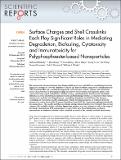Surface Charges and Shell Crosslinks Each Play Significant Roles in Mediating Degradation, Biofouling, Cytotoxicity and Immunotoxicity for Polyphosphoester-based Nanoparticles
Author(s)
Elsabahy, Mahmoud; Zhang, Shiyi; Zhang, Fuwu; Deng, Zhou J.; Lim, Young H.; Parsamian, Perouza; Wooley, Karen L.; Wang, Hai, Ph. D. Massachusetts Institute of Technology; Hammond, Paula T; ... Show more Show less
DownloadElsabahy-2013-Surface charges and.pdf (893.3Kb)
PUBLISHER_CC
Publisher with Creative Commons License
Creative Commons Attribution
Terms of use
Metadata
Show full item recordAbstract
The construction of nanostructures from biodegradable precursors and shell/core crosslinking have been pursued as strategies to solve the problems of toxicity and limited stability, respectively. Polyphosphoester (PPE)-based micelles and crosslinked nanoparticles with non-ionic, anionic, cationic, and zwitterionic surface characteristics for potential packaging and delivery of therapeutic and diagnostic agents, were constructed using a quick and efficient synthetic strategy, and importantly, demonstrated remarkable differences in terms of cytotoxicity, immunotoxicity, and biofouling properties, as a function of their surface characteristics and also with dependence on crosslinking throughout the shell layers. For instance, crosslinking of zwitterionic micelles significantly reduced the immunotoxicity, as evidenced from the absence of secretions of any of the 23 measured cytokines from RAW 264.7 mouse macrophages treated with the nanoparticles. The micelles and their crosslinked analogs demonstrated lower cytotoxicity than several commercially-available vehicles, and their degradation products were not cytotoxic to cells at the range of the tested concentrations. PPE-nanoparticles are expected to have broad implications in clinical nanomedicine as alternative vehicles to those involved in several of the currently available medications.
Date issued
2013-11Department
Massachusetts Institute of Technology. Department of Chemical Engineering; Koch Institute for Integrative Cancer Research at MITJournal
Scientific Reports
Publisher
Nature Publishing Group
Citation
Elsabahy, Mahmoud, Shiyi Zhang, Fuwu Zhang, Zhou J. Deng, Young H. Lim, Hai Wang, Perouza Parsamian, Paula T. Hammond, and Karen L. Wooley. “Surface Charges and Shell Crosslinks Each Play Significant Roles in Mediating Degradation, Biofouling, Cytotoxicity and Immunotoxicity for Polyphosphoester-based Nanoparticles.” Scientific Reports 3 (November 22, 2013).
Version: Final published version
ISSN
2045-2322